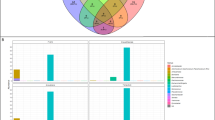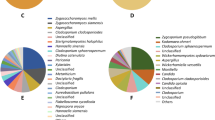Abstract
Varroa bee hive attack is a serious and common problem in bee keeping. In our work, an ecto-microflora of Varroa destructor mites was characterised as a potential source of bacterial bee diseases. Using a cultivation approach, a variable population of bacteria was isolated from the body surface of Varroa mites with frequency of about 150 cfu per mite individual. Nine studied isolates were classified to four genera and six species by a combination of matrix-assisted laser desorption ionization time-of-flight (MALDI-TOF)- and 16S ribosomal RNA (rRNA)-based methods, suggesting relatively low diversity of Varroa mite-associated ecto-microflora. The Varroa mite-associated bacterial population was found to be dominated by Gram-positive bacteria of Bacillus and Microbacterium genera. Gram-negative bacteria were represented by members of Brevundimonas and Rhizobium genera. Most of the identified species are not known to be associated with Varroa mite, either honey bee or honey up until now and some of them are probably representatives of new bacterial taxa.



Similar content being viewed by others
References
Alippi, A.M. (1995) Detection of Bacillus larvae spores in Argentinian honeys by using a semi-selective medium. Microbiologia. 11(3), 343–350
Alippi, A.M., Albo, G.N., Marcangeli, J., Leniz, D., Noriega, A. (1995) The mite Varroa jacobsoni does not transmit American foulbrood from infected to healthy colonies. Exp. Appl. Acarol. 19(10), 607–613
Alippi, A.M., Reynaldi, F.J., López, A.C., De Giusti, M.R., Aguilar, O.M. (2004) Molecular epidemiology of Paenibacillus larvae larvae and incidence of American foulbrood in Argentinean honeys from Buenos Aires Province. J. Apic. Res. 43(3), 135–143
Apte-Deshpande, A., Paingankar, M., Gokhale, M.D., Deobagkar, D.N. (2012) Serratia odorifera a midgut inhabitant of Aedes aegypti mosquito enhances its susceptibility to dengue-2 virus. PLoS ONE . doi:10.1371/journal.pone.0040401
Ball, B.V. (1985) Acute paralysis virus isolated from honeybee colonies infested with Warroa jacobsoni. J. Apic. Res. 24, 115–119
Ball, B.V. (1997) Secondary infections and diseases associated with Varroa jacobsoni. Options Méditerranéennes. 21, 49–58
Beilstein, F., Dreiseikelmann, B. (2006) Bacteriophages of freshwater Brevundimonas vesicularis isolates. Res. Microbiol. 157(3), 213–219
Benoit, J.B., Yoder, J.A., Sammataro, D., Zettler, L.W. (2004) Mycoflora and fungal vector capacity of the parasitic mite Varroa destructor (Mesostigmata: Varroidae) in honey bee (Hymenoptera: Apidae) colonies. Int. J. Acarol. 30(2), 103–106
Berényi, O., Bakonyi, T., Derakhshifar, I., Köglberger, H., Nowotny, N. (2006) Occurrence of six honeybee viruses in diseased Austrian apiaries. Appl. Environ. Microbiol. 72(4), 2414–2420
Boecking, O., Genersch, E. (2008) Varroosis - the ongoing crisis in bee keeping. J. Verbr. Lebensm. 3(2), 221–228
Bouzar, H., Jones, J.B., Hodge, N.C. (1993) Differential characterization of Agrobacterium species using carbon source utilization pattern and fatty acid profiles. Phytopathology 83(7), 733–739
Bowen-Walker, P.L., Gunn, A. (2001) The effect of the ectoparasitic mite, Varroa destructor on adult worker honeybee (Apis mellifera) emergence weights, water, protein, carbohydrate, and lipid levels. Entomol. Exp. Appl. 101, 207–217
Bowen-Walker, P.L., Martin, S.J., Gunn, A. (1999) The transmission of deformed wing virus between honeybees (Apis mellifera L.) by the ectoparasitic mite Varroa jacobsoni Oud. J. Invertebr. Pathol 73(1), 101–106
Chen, Y.P., Siede, R. (2007) Honey bee viruses. Adv. Virus Res. 70, 33–80
Chen, Y.P., Pettis, J.S., Evans, J.D., Kramer, M., Feldlaufer, M.F. (2004) Transmission of Kashmir bee virus by the ectoparasitic mite Varroa destructor. Apidologie. 35(4), 441–448
Davis, E.P., Boopathy, R., Manning, J. (1997) Use of trinitrobenzene as a nitrogen source by Pseudomonas vesicularis isolated from soil. Curr. Microbiol. 34(3), 192–197
De la Rúa, P., Jaffé, R., Dall’Olio, R., Muñoz, I., Serrano, J. (2009) Biodiversity, conservation and current threats to European honeybees. Apidologie 40(3), 263–284
De Rycke, P.H., Joubert, J.J., Hosseinian, S.H., Jacobs, F.J. (2002) The possible role of Varroa destructor in the spreading of American foulbrood among apiaries. Exp. Appl. Acarol. 27(4), 313–318
Dworkin, M., Falkow, S., Rosemberg, E., Schleifer, K.H., Stackebrandt, E. (2006) The Prokaryotes: A Handbook on the Biology of Bacteria. Springer, Berlin
Egemen, O., Ozkaya, O., Bingol, D., Akan, M. (2012) Rhizobium radiobacter: an unusual pathogen isolated on an active chronic ulcerous inflammation. J. Plast. Reconstr. Aes. 65(8), 233–235
Escobar, M.A., Dandekar, A.M. (2003) Agrobacterium tumefaciens as an agent of disease. Trends Plant Sci. 8(8), 380–386
Ferreira, L., Sánchez-Juanes, F., García-Fraile, P., Rivas, R., Mateos, P.F., et al. (2011) MALDI-TOF Mass Spectrometry Is a Fast and Reliable Platform for Identification and Ecological Studies of Species from Family Rhizobiaceae. PLoS ONE 6(5), e20223
Funke, G., Haase, G., Schnitzler, N., Schrage, N., Reinert, R.R. (1997) Endophthalmitis due to Microbacterium species: case report and review of microbacterium infections. Clin. Infect. Dis. 24(4), 713–716
Genersch, E. (2010) American Foulbrood in honeybees and its causative agent, Paenibacillus larvae. J. Invertebr. Pathol. 103(suppl. 1), 10–19
Gilliam, M. (1978) Bacteria belonging to the genus Bacillus isolated from selected organs of queen honey bees, Apis mellifera. J. Invertebr. Pathol. 31(3), 389–391
Gilliam, M. (1979) Microbiology of pollen and bee bread: the genus Bacillus. Apidologie 10(3), 269–274
Gilliam, M., Prest, D.B. (1987) Microbiology of feces of the larval honey bee, Apis mellifera. J. Invertebr. Pathol. 41(1), 70–75
Gilliam, M., Valentine, D.K. (1976) Bacteria isolated from the intestinal contents of foraging worker honey bees, Apis mellifera: the genus Bacillus. J. Invertebr. Pathol. 28(2), 275–276
Gliński, Z., Jarosz, J. (1992) Varroa jacobsoni as a carrier of bacterial infections to a recipient bee host. Apidologie 23(1), 25–31
Gutiérrez, A.M., Cabriales, J.J.P., Vega, M.M. (2010) Isolation and characterization of hexavalent chromium-reducing rhizospheric bacteria from a wetland. Int. J. Phytoremediation 12(4), 317–334
Hung, W.L., Wade, W.G., Boden, R., Kelly, D.P., Wood, A.P. (2011) Facultative methylotrophs from the human oral cavity and methylotrophy in strains of Gordonia, Leifsonia, and Microbacterium. Arch. Microbiol. 193(6), 407–417
Indiragandhi, P., Yoon, C., Yang, J.O., Cho, S., Sa, T.M., Kim, G.H. (2010) Microbial communities in the developmental stages of B and Q biotypes of sweet potato whitefly, Bemisia tabaci (hemiptera: Aleyrodidae). J. Korean Soc. Appl. Biol. Chem. 53(5), 605–617
Iurlina, M.O., Fritz, R. (2005) Characterization of microorganisms in Argentinean honeys from different sources. Int. J. Food Microbiol. 105(3), 297–304
Kacaniova, M., Chlebo, R., Kopernicky, M., Trakovicka, A. (2004) Microflora of the honeybee gastrointestinal tract. Folia Microbiol. 49(2), 169–171
Kim, O.S., Cho, Y.J., Lee, K., Yoon, S.H., Kim, M., et al. (2012) Introducing EzTaxon-e: a prokaryotic 16S rRNA Gene sequence database with phylotypes that represent uncultured species. Int. J. Syst. Evol. Microbiol. 62(3), 716–721
Kotiranta, A., Lounatmaa, K., Haapasalo, M. (2000) Epidemiology and pathogenesis of Bacillus cereus infections. Microbes Infect. 2(2), 189–198
Laffineur, K., Avesani, V., Cornu, G., Charlier, J., Janssens, M., Wauters, G., Delmée, M. (2003) Bacteremia due to a novel Microbacterium species in a patient with leukemia and description of Microbacterium paraoxydans sp. nov. J. Clin. Microbiol. 41(5), 2242–2246
Le Conte, Y., Ellis, M., Ritter, W. (2010) Varroa mites and honey bee health: can Varroa explain part of the colony losses? Apidologie 41(3), 353–363
Maniatis, T., Fritsch, E.F., Sambrook, J. (1982) Molecular Cloning: a Laboratory Manual. Cold Spring Harbor Laboratory. Cold Spring Harbor, New York
Morais, P.V., da Costa, M.S. (1990) Alterations in the major heterotrophic bacterial populations isolated from a still bottled mineral water. J. Appl. Bacteriol. 69(5), 750–757
Mounier, J., Rea, M.C., O’Connor, P.M., Fitzgerald, G.F., Cogan, T.M. (2007) Growth characteristics of Brevibacterium, Corynebacterium, Microbacterium, and Staphylococcus spp. isolated from surface-ripened cheese. Appl. Environ. Microbiol. 73(23), 7732–7739
Nazzi, F., Brown, S.P., Annoscia, D., Piccolo, F.D., Prisco, G.D., Varricchio, P., Vedova, G.D., Cattonaro, F., Caprio, E., Pennacchio, F. (2012) Synergistic parasite-pathogen interactions mediated by host immunity can drive the collapse of honeybee colonies. PLoS Pathog . doi:10.1371/journal.ppat.1002735
Oldroyd, B.P. (1999) Coevolution while you wait: Varroa jacobsoni, a new parasite of western honeybees. Trends Ecol. Evol. 14(8), 312–315
Pospiech, A., Neumann, B. (1995) A versatile quick-prep of genomic DNA from Gram-positive bacteria. Trends Genet. 11(6), 217–218
Reddy, C.A., Beveridge, T.J., Breznak, J.A., Marzluf, G.A., Schmidt, T.M., Snyder, L.R. (2007) Methods for General and Molecular Microbiology. ASM Press, Washington DC. ISBN: 1555812236
Ringø, E., Sperstad, S., Kraugerud, O.F., Krogdahl, Å. (2008) Use of 16S rRNA gene sequencing analysis to characterize culturable intestinal bacteria in Atlantic salmon (Salmo salar) fed diets with cellulose or non-starch polysaccharides from soy. Aquat. Res. 39(10), 1087–1100
Rosenkranz, P., Aumeier, P., Ziegelmann, B. (2009) Biology and control of Varroa destructor. J. Invertebr. Pathol. 103(suppl. 1), 96–119
Shang, S.T., Chiu, S.K., Chan, M.C., Wang, N.C., Yang, Y.S., Lin, J.C., Chang, F.Y. (2012) Invasive Brevundimonas vesicularis bacteremia: Two case reports and review of the literature. J. Microbiol. Immunol. Infect. 45(6), 468–472
Shen, M.Q., Cui, L.W., Ostiguy, N., Cox-Foster, D. (2005) Intricate transmission routes and interactions between picorna-like viruses (Kashmir bee virus and sacbrood virus) with the honeybee host and the parasitic varroa mite. J. Gen. Virol. 86(8), 2281–2289
Shi, W., Syrenne, R., Sun, J.Z., Yuan, J.S. (2010) Molecular approaches to study the insect gut symbiotic microbiota at the ‘omics’ age. Insect Sci. 17(3), 199–219
Shivaji, S., Reddy, G.S., Aduri, R.P., Kutty, R., Ravenschlag, K. (2004) Bacterial diversity of a soil sample from Schirmacher Oasis. Antarctica. Cell Mol. Biol. 50(5), 525–536
Shivaji, S., Chaturvedi, P., Suresh, K., Reddy, G.S.N., Dutt, C.B.S., Wainwright, M., Narlikar, J.V., Bhargava, P.M. (2006) Bacillus aerius sp. nov., Bacillus aerophilus sp. nov., Bacillus stratosphericus sp. nov. and Bacillus altitudinis sp. nov., isolated from cryogenic tubes used for collecting air samples from high altitudes. Int. J. Syst. Evol. Microbiol. 56(7), 1465–1473
Snowdon, A.J., Cliver, D.O. (1996) Microorganisms in honey. Int. J. Food Microbiol. 31(1–3), 1–26
Tamura, K., Peterson, D., Peterson, N., Stecher, G., Nie, M., Kumar, S. (2011) MEGA5: molecular evolutionary genetics analysis using maximum likelihood, evolutionary distance, and maximum parsimony methods. Mol. Biol. Evol. 28(10), 2731–2739
van Belkum, A., Welker, M., Erhard, M., Chatellier, S. (2012) Biomedical mass spectrometry in today’s and tomorrow’s clinical microbiology laboratories. J. Clin. Microbiol. 50(5), 1513–1517
Vilanova, C., Marco, G., Domínguez-Escribà, L., Genovés, S., Sentandreu, V., Bataller, E., Ramón, D., Porcar, M. (2012) Bacteria from acidic to strongly alkaline insect midguts: potential sources of extreme cellulolytic enzymes. Biomass Bioenerg. 45, 288–294
Weisburg, W.G., Barns, S.M., Pelletier, D.A., Lane, D.J. (1991) 16S ribosomal DNA amplification for phylogenetic study. J. Bacteriol. 173(2), 697–703
Yang, M.L., Chen, I.H., Chen, T.C., Lin, W.R., Lin, C.Y., Lu, P.L. (2006) Case report: infective endocarditis caused by Brevundimonas vesicularis. BMC Infect. Dis. 6, 179
Young, J.M., Kuykendall, L.D., Martinez–Romero, E., Kerr, A., Sawada, H. (2001) A revision of Rhizobium Frank 1889, with an emended description of the genus, and the inclusion of all species of Agrobacterium Conn 1942 and Allorhizobium undicola de Lajudie et al. 1998 as new combinations: Rhizobium radiobacter, R. rhizogenes, R. rubi, R. undicola and R. vitis. Int. J. Syst. Evol. Microbiol. 51(1), 89–103
Acknowledgments
This work was supported by the Slovak Grant Agency VEGA, grant no. VEGA 2/0016/12.
Author information
Authors and Affiliations
Corresponding author
Additional information
Manuscript editor: Yves Le Conte
Bactéries hétérotrophes associées à Varroa destructor
Varroa destructor/ Acari/ Microbacterium/ microflore externe/ hétérotrophie
Die Assoziation heterotropher Bakterien mit der Milbe Varroa destructor
Varroa destructor/ Ekto-Mikroflora/ Microbacterium/ heterotrophe Bakterien
Rights and permissions
About this article
Cite this article
Vanikova, S., Noskova, A., Pristas, P. et al. Heterotrophic bacteria associated with Varroa destructor mite. Apidologie 46, 369–379 (2015). https://doi.org/10.1007/s13592-014-0327-9
Received:
Revised:
Accepted:
Published:
Issue Date:
DOI: https://doi.org/10.1007/s13592-014-0327-9




